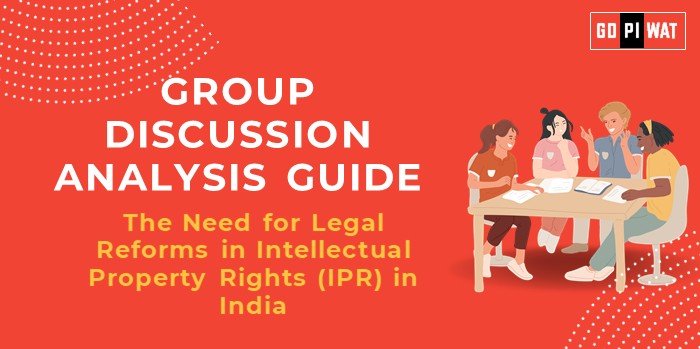📋 GD Analysis Guide: The Need for Legal Reforms in Intellectual Property Rights (IPR) in India
🌐 Introduction to the Topic
Opening Context: Intellectual Property Rights (IPR) are critical for fostering innovation, ensuring global competitiveness, and protecting creators’ rights. However, India’s IPR frameworks face criticism for being outdated and poorly enforced, necessitating urgent reforms.
Topic Background: While India’s IPR journey began with the Patents Act of 1970, globalization and technological advances have exposed gaps in areas like patent delays, piracy, and protecting indigenous knowledge. Aligning with international standards like TRIPS is now imperative.
📊 Quick Facts and Key Statistics
- 📉 Global Rank in IP Index (2024): 43/53 – Highlights limited enforcement capabilities.
- 🕒 Patent Pendency: Over 25,000 applications await review, impacting innovation timelines.
- 🔍 Piracy Rate: 60% in software (BSA, 2023) – Indicates weak copyright enforcement.
- 💸 Economic Impact: Weak IPR enforcement costs India $1.3 billion annually (WIPO, 2023).
- 📈 Innovation Ranking: 40th in the Global Innovation Index – Highlights growth potential.
👥 Stakeholders and Their Roles
- 🏛️ Government Agencies: Frame laws, reduce patent pendency, protect traditional knowledge.
- 💡 Creators and Innovators: Secure rights to ensure profitability and incentivize creativity.
- 🏢 Corporations: Seek strong IP frameworks for R&D investments.
- 🌍 International Organizations: Set standards and mediate disputes (e.g., WIPO, WTO).
- 👥 Civil Society: Advocate for balanced reforms considering access and affordability.
🏆 Achievements and Challenges
📈 Achievements:
- ✅ Ease of Doing Business: IP-related reforms improved India’s World Bank Index rank.
- 🚀 Start-up Support: Fast-track IPR registration through initiatives like Start-up India.
- 🌿 Indigenous Knowledge: Traditional Knowledge Digital Library (TKDL) combats biopiracy.
⚠️ Challenges:
- 🕒 Patent Delays: Approval times exceed 5 years.
- 📺 Piracy: Rampant violations in entertainment and software sectors.
- 🌏 Indigenous Exploitation: Poor protection of traditional arts and medicinal knowledge.
🌍 Global Comparisons
- 🇺🇸 USA: Robust IP enforcement incentivizes innovation.
- 🇨🇳 China: Aggressive patent filings supported by competitive ecosystems.
Case Studies:
- 🌾 Basmati Rice Case: India’s legal battle to protect geographical indications.
- 💻 AIIMS Software Piracy Incident: Exposed risks of weak enforcement.
🗣️ Structured Arguments for Discussion
- ✔️ Supporting Stance: “Effective IPR reforms attract FDI, enhance R&D, and reduce economic losses from piracy.”
- ❌ Opposing Stance: “Excessive IPR protection may hinder accessibility, especially in pharmaceuticals.”
- ⚖️ Balanced Perspective: “IPR reforms must balance innovation incentives with accessibility concerns.”
📝 Effective Discussion Approaches
- 📊 Opening Statements:
- “India ranks 43rd globally in IP enforcement, reflecting a need for robust reforms.”
- “The Basmati Rice GI battle underscores the risks of weak IPR protections.”
- 🔄 Counter-Argument Handling:
- Acknowledge affordability concerns in pharma but highlight solutions like compulsory licensing under TRIPS.
📈 Strategic Analysis of Strengths and Weaknesses
- ✅ Strengths: Vibrant start-up ecosystem, global IP awareness campaigns.
- ❌ Weaknesses: Lengthy approval processes, low public awareness.
- 🌟 Opportunities: Integrating AI to expedite patent reviews, leveraging trade agreements.
- ⚠️ Threats: Global disputes, biopiracy risks.
📚 Connecting with B-School Applications
Real-World Applications: Use cases in business law or innovation management courses.
- 📋 Sample Questions:
- “How do IPR laws impact innovation and entrepreneurship in India?”
- “What measures can address biopiracy effectively?”
- 💡 Insights for Students: Understanding IP fosters global business insights and balances ethics with profit in product lifecycle management.


